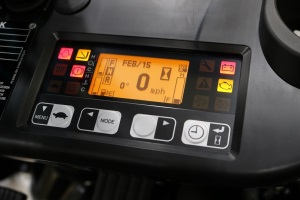Complete Powerpoint slide presentation for forklift instructors. Ready made training course
the evolution of forklift smart screen technology
 This interesting article by Trinton Castetter of Toyota forklifts looks at the evolution of smart screen technology on forklift trucks.
This interesting article by Trinton Castetter of Toyota forklifts looks at the evolution of smart screen technology on forklift trucks.
The material handling industry relies on technological evolution. Like the progression of cellular phones from the simplistic brick phones of the ‘80s to the handheld computers of today, forklift displays have seen rapid advancements in technology and functionality. From basic instrument panels to advanced touch-screen displays, let’s take a look at how this evolution has taken place over the course of Toyota’s history.
Toyota’s First Forklift Sold in the U.S.
In 1967, the first Toyota forklift was sold in the United States. As you can imagine, the instruments available then were limited compared to today’s complex systems. The LA 1-ton model came standard with water and torque converter oil temperature gauges as well as an hour meter to track overall usage. While not the most sophisticated system, these tools provided sufficient information for a time period when forklift usage was light and systems were relatively simplistic.
First U.S.-Built Forklift
In 1986, Toyota launched the 5-series internal combustion engine forklifts, which were the first Toyota IC forklifts to come standard with a combination meter. Consequently, the 5FGCU25 model was actually the first Toyota forklift manufactured in the United States. In addition to the temperature and fuel gauges and the hour meter, the 5-series’ display included various indicator lights to warn operators of certain conditions. These indicators included a clogged air cleaner warning, parking brake indicator, engine oil pressure warning, and many others.
Toyota’s First LCD Digital Display
Toyota began producing their 5-series, 4-wheel electric models in 1991, which featured Toyota’s first use of an LCD digital display. The display featured a back light for illumination in low light settings and an LCD panel heater that turned on automatically in low temperatures. Additional functionalities included: a speedometer, pump and motor hour meters, programmable speed control, over speed alarm, and lift interrupt capabilities.
8-Series Launch
When Toyota’s 8-series IC forklifts launched in 2008, they sported more than just overhauled appearance and performance. The multi-function display also changed to an LCD style display and took up a new home on the dash of the forklift. The brightly lit display’s status screen featured many useful indicators including a speedometer, maintenance reminder, and torque converter temperature indicator.
In addition to the 7-series’ extensive list of capabilities, the 8-series saw new features added, including an eco-mode indicator, engine auto stop time setting, and the ability to set a second administrator password.
With the launch of the High-Capacity Adjustable Wheelbase models in 2018, Toyota introduced its first ever touch screen, multi-function display on a forklift. The 7-inch display, which is now standard on nearly all Toyota Heavy Duty models, boasts tools and functions never seen before on material handling equipment. A built-in capacity calculator provides estimated capacity based on certain inputs such as load center and attachment. Operator manuals, service manuals, engine diagnostics, and fuse diagrams are now all available at an operator’s fingertips. Optional camera systems and customizable pre-operation checklists can also be integrated into the system.

The Future of Smart Screen Technology
While these technological advancements are fascinating, today’s forklifts aren’t limited to the capabilities of integrated displays. Many customers are using telematics systems and auxiliary computers to monitor forklift usage, control inventory, and much more. As new advancements develop for integrated screens, some of this functionality could begin to be incorporated into them. I’m not saying you’ll be able to place your Starbucks order through them anytime soon, but more advanced monitoring capabilities certainly aren’t out of the question. Regardless of what the future holds, you can count on Toyota continuing to be at the forefront of smart screen innovation for years to come.
Disclaimer. The legislative information contained on this web site is my interpretation of the law based on many years in the health and safety business. A definitive interpretation can only be given by the courts. I will therefore not be held responsible for any accident/incident/prosecution arising as a consequence of anyone using any information obtained from this web site.